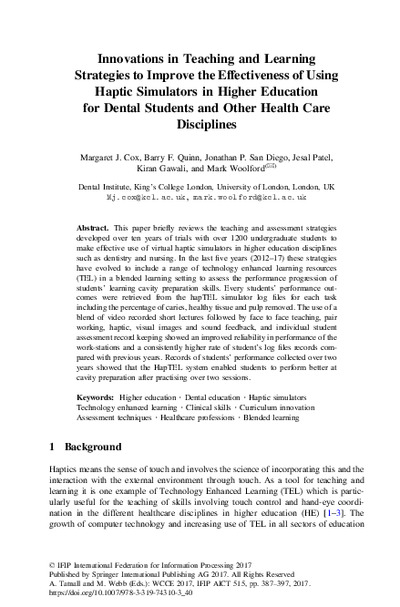Innovations in Teaching and Learning Strategies to Improve the Effectiveness of Using Haptic Simulators in Higher Education for Dental Students and Other Health Care DisciplinesMargaret J. Cox, Barry F. Quinn, Jonathan San Diego, Jesal Patel, Kiran Gawali, Mark Woolford
Zu finden in: Tomorrow's Learning: Involving Everyone. Learning with and about Technologies and Computing (Seite 387 bis 397), 2017
  |
 |
 Diese Seite wurde seit 4 Jahren inhaltlich nicht mehr aktualisiert.
Unter Umständen ist sie nicht mehr aktuell.
Diese Seite wurde seit 4 Jahren inhaltlich nicht mehr aktualisiert.
Unter Umständen ist sie nicht mehr aktuell.
 Zusammenfassungen
Zusammenfassungen
 This paper briefly reviews the teaching and assessment strategies developed over ten years of trials with over 1200 undergraduate students to make effective use of virtual haptic simulators in higher education disciplines such as dentistry and nursing. In the last five years (2012–17) these strategies have evolved to include a range of technology enhanced learning resources (TEL) in a blended learning setting to assess the performance progression of students’ learning cavity preparation skills. Every students’ performance outcomes were retrieved from the hapTEL simulator log files for each task including the percentage of caries, healthy tissue and pulp removed. The use of a blend of video recorded short lectures followed by face to face teaching, pair working, haptic, visual images and sound feedback, and individual student assessment record keeping showed an improved reliability in performance of the work-stations and a consistently higher rate of student’s log files records compared with previous years. Records of students’ performance collected over two years showed that the HapTEL system enabled students to perform better at cavity preparation after practising over two sessions.
This paper briefly reviews the teaching and assessment strategies developed over ten years of trials with over 1200 undergraduate students to make effective use of virtual haptic simulators in higher education disciplines such as dentistry and nursing. In the last five years (2012–17) these strategies have evolved to include a range of technology enhanced learning resources (TEL) in a blended learning setting to assess the performance progression of students’ learning cavity preparation skills. Every students’ performance outcomes were retrieved from the hapTEL simulator log files for each task including the percentage of caries, healthy tissue and pulp removed. The use of a blend of video recorded short lectures followed by face to face teaching, pair working, haptic, visual images and sound feedback, and individual student assessment record keeping showed an improved reliability in performance of the work-stations and a consistently higher rate of student’s log files records compared with previous years. Records of students’ performance collected over two years showed that the HapTEL system enabled students to perform better at cavity preparation after practising over two sessions. Dieses Kapitel erwähnt ...
Dieses Kapitel erwähnt ...
 Personen KB IB clear | Helen Beetham , Margaret J. Cox , Diana Laurillard , Rhona Sharpe | ||||||||||||||||||||||||||||||||||||
 Begriffe KB IB clear | Blended LearningBlended Learning
,  Innovation Innovation innovation innovation
| ||||||||||||||||||||||||||||||||||||
 Bücher |
| ||||||||||||||||||||||||||||||||||||
 Texte |
|
 Zitationsgraph
Zitationsgraph
 Zitationsgraph (Beta-Test mit vis.js)
Zitationsgraph (Beta-Test mit vis.js)
 Anderswo finden
Anderswo finden
 Volltext dieses Dokuments
Volltext dieses Dokuments
 |  Innovations in Teaching and Learning Strategies to Improve the Effectiveness of Using Haptic Simulators in Higher Education for Dental Students and Other Health Care Disciplines: Artikel als Volltext bei Springerlink ( Innovations in Teaching and Learning Strategies to Improve the Effectiveness of Using Haptic Simulators in Higher Education for Dental Students and Other Health Care Disciplines: Artikel als Volltext bei Springerlink ( : :  , 2314 kByte; , 2314 kByte;  : :  ) ) |
 Anderswo suchen
Anderswo suchen 
 Beat und dieses Kapitel
Beat und dieses Kapitel
Beat hat Dieses Kapitel während seiner Zeit am Institut für Medien und Schule (IMS) ins Biblionetz aufgenommen. Er hat Dieses Kapitel einmalig erfasst und bisher nicht mehr bearbeitet. Beat besitzt kein physisches, aber ein digitales Exemplar. Eine digitale Version ist auf dem Internet verfügbar (s.o.). Aufgrund der wenigen Einträge im Biblionetz scheint er es nicht wirklich gelesen zu haben. Es gibt bisher auch nur wenige Objekte im Biblionetz, die dieses Werk zitieren.












 Biblionetz-History
Biblionetz-History